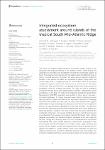Integrated ecosystem assessment around islands of the tropical South Mid-Atlantic Ridge
| dc.contributor.author | Rodrigues, AR | |
| dc.contributor.author | Floeter, SR | |
| dc.contributor.author | Gomes, V | |
| dc.contributor.author | Ferrari, DS | |
| dc.contributor.author | Giglio, VJ | |
| dc.contributor.author | Silva, FC | |
| dc.contributor.author | Liedke, AMR | |
| dc.contributor.author | Ferreira, CEL | |
| dc.contributor.author | Howell, Kerry | |
| dc.contributor.author | Gasalla, MA | |
| dc.date.accessioned | 2023-04-28T15:13:27Z | |
| dc.date.available | 2023-04-28T15:13:27Z | |
| dc.date.issued | 2023-04-04 | |
| dc.identifier.issn | 2296-7745 | |
| dc.identifier.issn | 2296-7745 | |
| dc.identifier.other | ARTN 1001676 | |
| dc.identifier.uri | https://pearl.plymouth.ac.uk/handle/10026.1/20773 | |
| dc.description.abstract |
<jats:p>The South Mid Atlantic Ridge comprises three main oceanic islands in the equatorial and tropical portions of the Atlantic Ocean. These islands are isolated from each other and equidistant from both the continental margins of South America and Africa, sharing common patterns but with different types of human use and pressures. Moreover, the areas beyond national jurisdiction between those islands are visited and exploited by distant fishing fleets and include large areas of shipping activity for commodities. Here, a pioneering integrated ecosystem assessment (IEA) process is constructed for the region among Saint Peter and Saint Paul’s Archipelago (Brazil), Saint Helena Island and Ascension Island (UK overseas territories). For that, we used a qualitative assessment of risks arising from anthropogenic activities, representing a novel contribution to the field. The Options for Delivering Ecosystem-Based Marine Management (ODEMM) approach was applied to trace sector–pressure–component pathways. A ‘linkage framework’ was outlined including pressures affecting each ecosystem component, and supported a process of knowledge attributions that scored the impact risks. All results were validated with regional stakeholders through workshops, including local and international management bodies, non-governmental organizations (NGOs) and scientists. The approach focused on a significant area among encompassing the open ocean, shallow and deep-sea biomes, analyzing the main sectors and pressures affecting the ecological components. Our results identified 14 sectors and 16 key pressures associated with 23 ecosystem components, totaling 780 impact chains. Fishing, shipping, wastewater, and tourism/recreation appeared as the top impacting sectors. Fishing and shipping were the most connected with ecosystem components links. Litter, species extraction, contaminants, and bycatch were the pressures that had the highest risk of impact values. Lastly, demersal and pelagic fish and pelagic and demersal elasmobranchs were the groups with the highest risk related to overall impacts, which were supported by local and regional evidence from long term monitoring programs and local studies. Our study demonstrated that these seemingly pristine islands and oceanic waters are already experiencing human impacts that should be addressed by local both conservation measures and international agreements. We also highlight the pressures that should be prioritized for better monitoring and policy, as well as those linkage components that have been less investigated.</jats:p> | |
| dc.format.extent | 1001676- | |
| dc.publisher | Frontiers Media SA | |
| dc.subject | integrated assessment | |
| dc.subject | ecosystem indicators | |
| dc.subject | multiple stressors | |
| dc.subject | tropical islands | |
| dc.subject | high seas | |
| dc.subject | anthropogenic activities | |
| dc.subject | impact risk | |
| dc.title | Integrated ecosystem assessment around islands of the tropical South Mid-Atlantic Ridge | |
| dc.type | journal-article | |
| dc.type | Journal Article | |
| plymouth.author-url | https://www.webofscience.com/api/gateway?GWVersion=2&SrcApp=PARTNER_APP&SrcAuth=LinksAMR&KeyUT=WOS:000969363900001&DestLinkType=FullRecord&DestApp=ALL_WOS&UsrCustomerID=11bb513d99f797142bcfeffcc58ea008 | |
| plymouth.volume | 10 | |
| plymouth.publication-status | Published online | |
| plymouth.journal | Frontiers in Marine Science | |
| dc.identifier.doi | 10.3389/fmars.2023.1001676 | |
| plymouth.organisational-group | |Plymouth | |
| plymouth.organisational-group | |Plymouth|Research Groups | |
| plymouth.organisational-group | |Plymouth|Faculty of Science and Engineering | |
| plymouth.organisational-group | |Plymouth|Faculty of Science and Engineering|School of Biological and Marine Sciences | |
| plymouth.organisational-group | |Plymouth|Research Groups|Marine Institute | |
| plymouth.organisational-group | |Plymouth|REF 2021 Researchers by UoA | |
| plymouth.organisational-group | |Plymouth|Users by role | |
| plymouth.organisational-group | |Plymouth|Users by role|Academics | |
| plymouth.organisational-group | |Plymouth|REF 2021 Researchers by UoA|UoA07 Earth Systems and Environmental Sciences | |
| plymouth.organisational-group | |Plymouth|Users by role|Researchers in ResearchFish submission | |
| dcterms.dateAccepted | 2023-03-10 | |
| dc.date.updated | 2023-04-28T15:13:26Z | |
| dc.rights.embargodate | 2023-4-29 | |
| dc.identifier.eissn | 2296-7745 | |
| dc.rights.embargoperiod | forever | |
| rioxxterms.versionofrecord | 10.3389/fmars.2023.1001676 |


